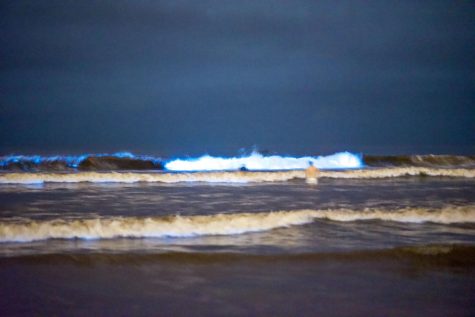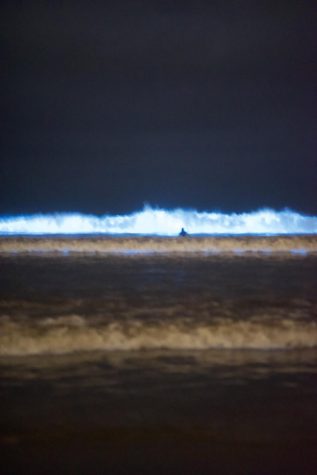San Diego Awakens at the Sight of Bioluminescence
San Diego Beaches Witness the Longest Bioluminescence Appearance in 25 Years
This past week, San Diego has been the hot topic of conversation all over the news, dragging residents to the oceanfront to see what all of the rave is about. The reason: the ocean’s now burgundy tint during the daytime has been transforming into a glistening electric blue shade at moments when the waves crash at night—the color being most vibrant about 2 hours after sunset.

The waves emit a fluorescent blue color at Moonlight Beach on April 28. Bioluminescent waves can be seen going up the coast of Southern California due to the algae bloom of L. poly phytoplankton.
This naturally-occurring sensation goes by the name of bioluminescence: “light produced by a chemical reaction within a living organism.” This striking sensation is more commonly known as the“red tide” and is actually an algae bloom of the type of dinoflagellate L. poly (Lingulodinium polyedra), a type of phytoplankton. The abundance of rain at the end of March, leading into the beginning of April is the primary factor that we have to thank for causing the profusion of L. poly: the mass amount of rain caused a runoff of nutrients into the ocean, promoting the growth of this phytoplankton.
L. poly operates on its circadian rhythm—meaning that its biological process is regulated on a daily basis based on the amount of light and temperature available—which is why you see the blue waves crashing at night, rather than during the daytime. It uses the light-emitting compound “luciferin” to produce brightness in the water and its pigment “peridinin” is credited for its fluorescent bluish-green color. The bioluminescence that this species produces is mesmerizing for us to see; however, not for the predators of L. poly—other marine organisms are sensitive to this color being produced, as they are physically incapable to process yellow, red, or violet colors. For this reason, bioluminescence is used as a defense mechanism for this particular phytoplankton.

Although it’s an irresistible reaction to witness, there are a few things that most people may not be aware of about the “red tide.” This algae bloom can oftentimes result in the emission of toxins into the ocean, capable of killing fish, shellfish, mammals, birds, and even affecting the health of humans. This is caused by the mass of phytoplankton using great amounts of oxygen in photosynthesis, therefore, low dissolved oxygen levels can be found in the water. Additionally, various species of phytoplankton are infamous for producing poisons or toxins, further contributing to the risk that the “red tide” poses.
However, Forbes assures that “this current bloom is dominated by non-toxic L. poly.”
“Scripps scientists have been monitoring the abundance of this organism since 1900,” Dr. Michael Latz of the Scripps Institution of Oceanography at UC San Diego claims, highlighting the appearance of “red tides” in 2011, 2013, 2018 and 2019.
While this certainly feels like an out of the ordinary and quite abnormal phenomenon to experience, it is actually not that uncommon in terms of how frequently this luminescence occurs (annually-speaking); however, it is quite rare for a round of bioluminescence to occur for such a long time.
According to NBC San Diego, “The last one off of San Diego’s coast that was of a similar size was back in 1995 during the America’s Cup yacht races.”
It is unpredictable how much longer this unfathomable occurrence will persist; undoubtedly, it is a phenomenal sight to take advantage of seeing.

